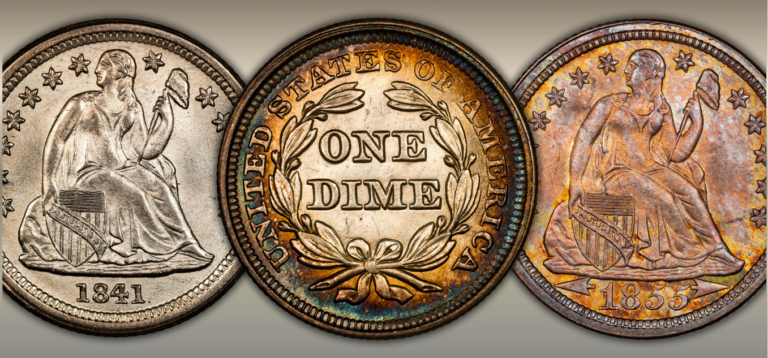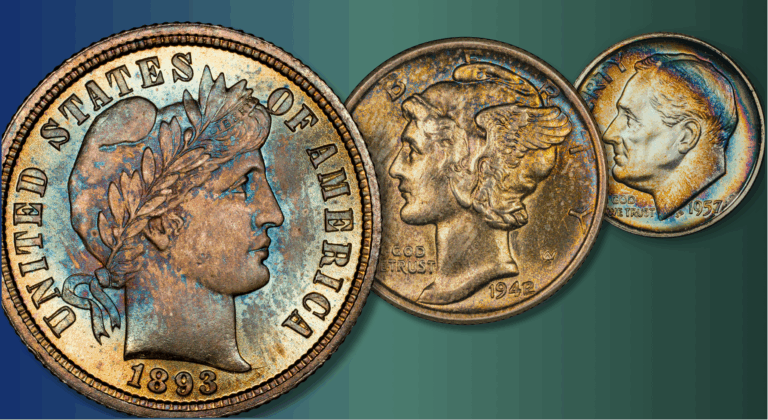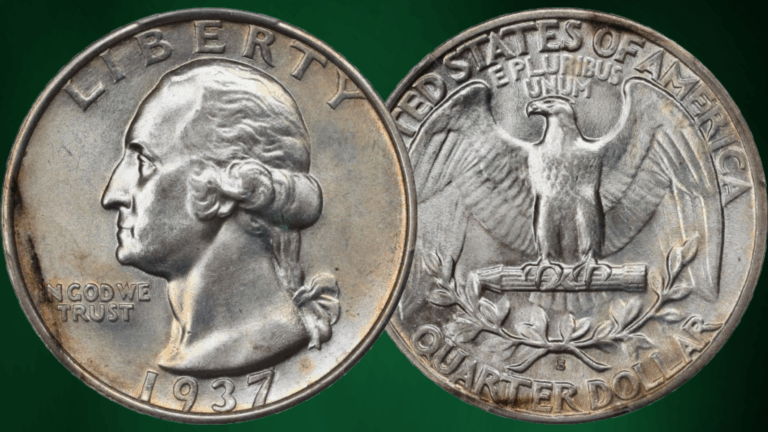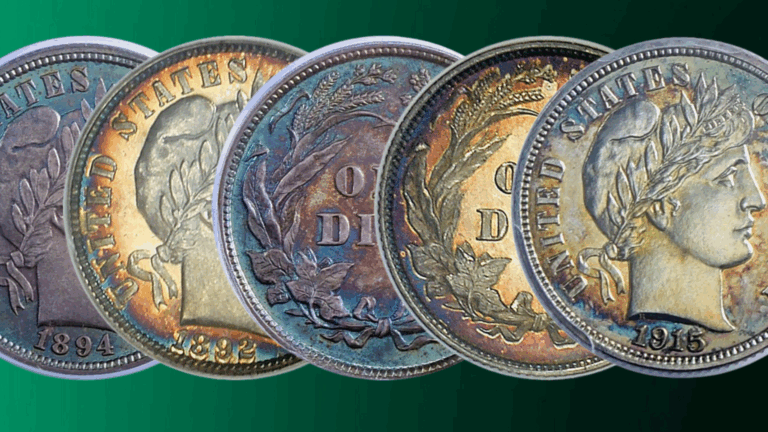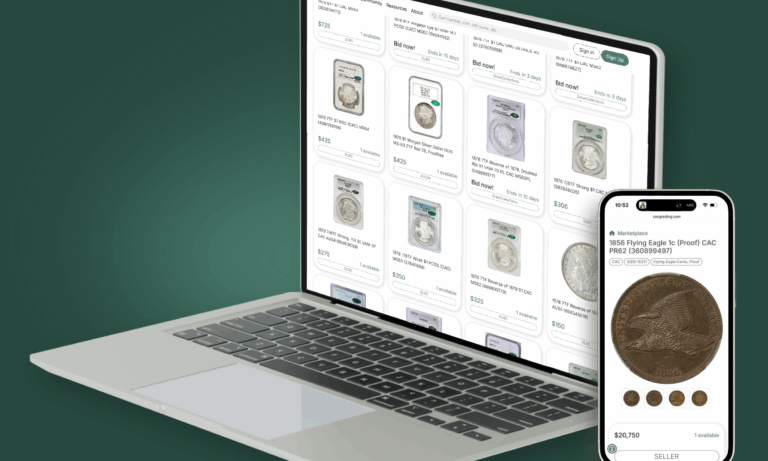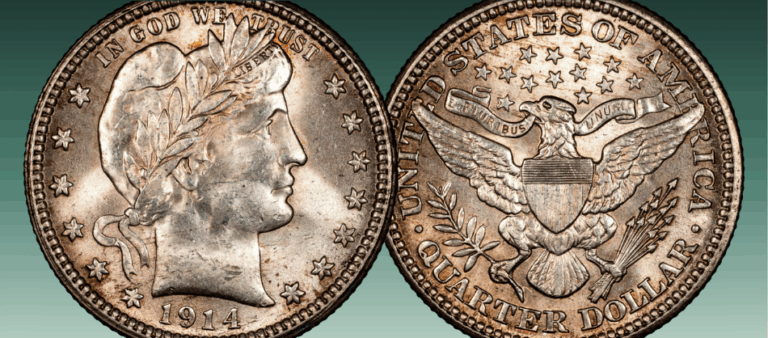by Greg Reynolds
The topic here is assembling a set ‘by date’ of Liberty Seated half dollars in Very Fine to Almost Uncirculated grades (VF-20 to AU-55). Usually, I find these to be more appealing and better values than Liberty Seated halves that are certified as grading from MS-60 to MS-63, which cost much more and often have distracting imperfections. In VF to AU grades, a set of halves from 1839 to 1891 that is missing three or four dates is not hard to finish. In this part, Liberty Seated halves minted from 1839 to 1852 are covered.
As listed in some of my other guides, there are thirteen types of classic U.S. half dollars: 1) Flowing Hair (1794-95); 2) Draped Bust, Small Eagle (1796-97) ; 3) Draped Bust, Heraldic Eagle (1801-07); 4) Reich Capped Bust, ‘Lettered Edge’ (1807-36); 5) Gobrecht Capped Bust, ‘Reeded Edge’ (1836-39); 6) Liberty Seated, No Drapery, No Motto (1839 only); 7) Liberty Seated, With Drapery, No Motto (1839-53, 1856-66); 8) Liberty Seated, Arrows & Rays (1853 only); 9) Liberty Seated, No Motto, With Arrows, No Rays (1854-55); 10) Liberty Seated, With Motto (1866-91 except 1874); 11) Liberty Seated, With Motto, With Arrows (1873-74); 12) Barber (1892-1915); 13) Walking Liberty (1916-47). Types #6 to #11 are Liberty Seated halves, which date from 1839 to 1891.
Type #6: No Drapery, No Motto (1839 only)
For half dollars, the differences between the ‘No Drapery’ type and the next type, ‘With Drapery,’ are slight. On Liberty Seated dimes, however, there is a great deal of difference between the two. ‘No Drapery’ halves are considered by tradition to be a separate design type, mostly to be consistent with classifications of dimes and quarters.
The “drapery” is not really drapery; it is a representation of fabric in Miss Liberty’s dress that hangs around her elbow. There are additional differences between the types. Like many words become customary, names sometimes become accepted by chance and circumstances, even if such names are not entirely clear or logical. An immediate point is that the terms ‘Drapery’ and ‘No Drapery’ should not be taken too literally; they are names used to classify design types.
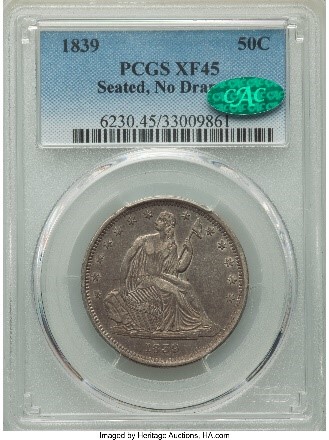
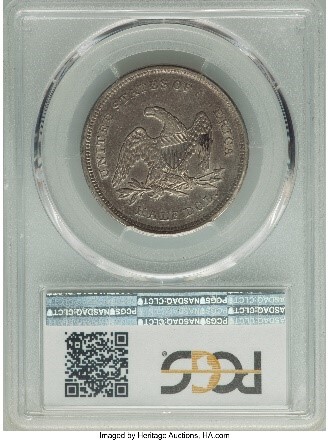
CAC has approved just fifty-nine 1839 ‘No Drapery’ halves in all grades, as of July 31, 2022. Circulated 1839 ‘No Drapery’ halves have been ‘under the radar’ since 2015 or earlier, in the sense that not much attention has been paid to them.
Quite a few CAC approved 1839 ‘No Drapery’ halves have been sold publicly over the last six years. It is not an especially difficult coin to find in Very Fine to AU grades, though it is subject to enhanced demand from collectors assembling type sets because it is a one-year only design type.
On May 8, 2022, Heritage auctioned a CAC approved XF-45 grade 1839 ‘No Drapery’ half for $2640, a fair collector price. In January 2022, the firm of Gerry Fortin sold a CAC approved AU-53 grade 1839 ‘No Drapery’ for $4015. On Feb. 23, 2020, the firm called GreatCollections sold a CAC approved VF-35 grade 1839 ‘No Drapery’ half for $1137.50.
Type #7: With Drapery, No Motto (1839-53, 1856-66)
All Liberty Seated halves struck from some point in 1839 onward are classified as being ‘With Drapery,’ which is really a code for a slightly different rendering of Miss Liberty. Missing ‘drapery’ on Liberty Seated halves dated after 1839 are not connected to the ‘No Drapery’ type; design detail was sometimes blurred or obliterated by grinding, lapping and/or polishing of dies at the mints.
On April 5, 2022, Stack’s Bowers auctioned a CAC approved XF-45 grade 1839 ‘With Drapery’ half for $900, a very strong price. While these probably increased in value during the first half of 2022, this $900 result is a little hard to understand. In July 2021, the firm of Gerry Fortin sold a CAC approved XF-45 1839 ‘With Drapery’ half for $575. On June 2, 2020, Heritage sold a CAC approved AU-50 grade 1839 ‘With Drapery’ half for $600, a fair collector price, though a mildly higher price would be fair, too.
For 1840 halves, there are two reverse (tail) varieties, one of which is particularly noteworthy. The so-called ‘Medium Letters’ reverse is said to be a product of a reverse die that was used in New Orleans to strike Gobrecht ‘Reeded Edge’ halves in 1838. The ‘O’ mintmark, however, was on the obverse (front of the coin) in 1838.
In “The Complete Guide to Liberty Seated Half Dollars” (Virginia Beach: DLRC Press, 1993), authors Randy Wiley and Bill Bugert asserted that two die pairings “are known” for 1840 half dollars with the “Original Reich Eagle Reverse” of 1838 with Medium Letters. In 1993, Wiley and Bugert referred to research they did in 1986 where they “diagnostically die linked the two 1840 obverses in these die pairings to identical 1842 obverses paired with reverses having [an ‘O’] mintmark.” Wiley and Bugert added that New Orleans Mint half dollars of 1840 had smaller diameters than 1840 Philadelphia Mint half dollars. It was thus concluded that 1840 ‘Medium Letters’ half dollars were struck in New Orleans without mintmarks.
While curious, this odd variety is not really required for a set ‘by date.’ An 1840 half with a regular reverse, called “Small Letters,” is sufficient. Even so, an 1840 ‘Medium Letters’ half that was struck in New Orleans is not extremely costly in the context of collecting Liberty Seated halves ‘by date,’ and is very noteworthy.
Liberty Seated halves had ‘Small Letters’ on the reverse (back) from 1839 to 1842. At some point during 1842, the so-called ‘Medium Letters’ reverse was adopted. The 1840 ‘Medium Letters’ reverse, which was left over from 1838, is significantly different from the ‘Medium Letters’ reverse that was introduced in 1842 as part of the Liberty Seated, No Drapery, No Motto design type. It is confusing for guides to refer to both these reverse designs just as ‘Medium Letters.’

CAC Approved Medium and Small Lettered Half Dollar Sales
In January 2021, Gerry Fortin sold a CAC approved XF-45 grade 1840, New Orleans Mint, Medium Letters half dollar for $2350. A CAC approved Very Fine grade representative of this variety could be found and purchased for a price between $1000 and $1800, depending upon its numerical grade, its eye appeal, and the circumstances of the transaction.
A regular 1840-O has a mintmark and so-called ‘Small Letters’ on the reverse. As a date, the 1840-O is not particularly rare. On April 17, 2022, GreatCollections sold a CAC approved, NGC graded XF-40 1840-O for $519.75, a wholesale price.
On Dec. 17, 2019, Heritage sold a CAC approved AU-50 grade 1841 for $660. During 2022, a fair collector price for this coin would probably be in the range of $725 to $800.
It is easy to find circulated 1841-O halves. My impression, though, is that few of those that grade below XF-40 have been submitted to CAC. In June 2021, Gerry Fortin sold a CAC approved VF-30 grade 1841-O for $250. In January 2021, Fortin sold a CAC approved AU-55 grade 1841-O for $850. As of July 20, 2022, the CPG-CAC medium retail price estimate for an XF-40 grade 1841-O is $546.
There are multiple often cited varieties of half dollars from the year 1842. In my view, the difference between the 1842 ‘Small Letters’ reverse and the 1842 ‘Medium Letters’ reverse, while noticeable, is not of tremendous importance. As the 1842 ‘Medium Letters’ reverse is less expensive, an 1842 with this reverse is sufficient for a set ‘by date.’ The 1842 ‘Small Letters’ reverse can logically be ignored in the context of a set ‘by date.’
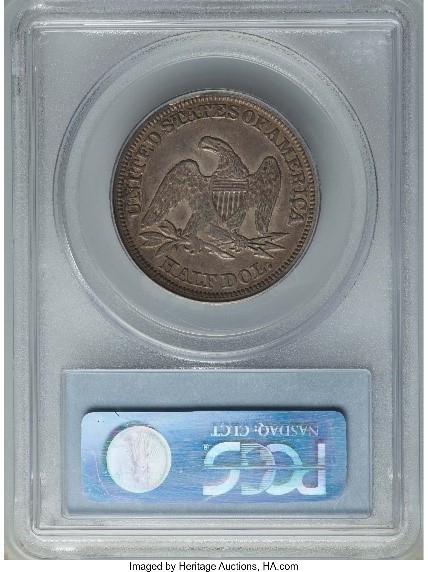
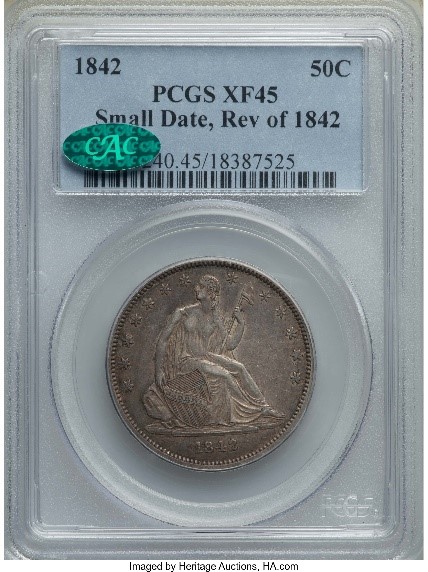
The importance of the distinction between the 1842 Small Date and the 1842 Medium Date is a different matter and is controversial. In cases where there are differences in the numerals for coins of the same type and year, it is often concluded that more than one date of the same year is required for a set ‘by date.’ In regard to 1842 halves, the difference between a ‘Small Date’ and a ‘Medium Date’ is readily apparent without magnification. It probably makes sense to include both in a set ‘by date.’
It is important to remember that a secondary, though often used, numismatic definition of the term ‘date’ refers to the physical numerals in the ‘year’ on the coin. In the context of Liberty Seated halves, the terms ‘Small Letters’ and ‘Medium Letters’ refer to the size of the letters on the reverse.
In March 2022, Gerry Fortin sold a CAC approved AU-55 grade 1842 Small Date, Medium Letters for $1952. Back on May 8, 2018, Heritage sold a CAC approved XF-45 grade 1842 Small Date, Medium Letters half for $348. As of July 31, 2022, the CPG-CAC retail price estimate for this coin is $429.
In circulated grades, the 1842 ‘Medium Date’ and the 1842-O ‘Medium Date’ are not especially expensive and not very difficult to find. As far as I know, all the surviving 1842-O halves with a ‘Small Date’ obverse are paired with the ‘Small Letters’ reverse. CAC reports nine of these in the VF-20 to AU-55 grade range. To the best of my knowledge, the most recent public sale of one of these nine was an XF-45 grade coin that Gerry Fortin sold for $5500 in April 2020.
On June 11, 2021, Stack’s Bowers auctioned a PCGS graded VF-20 1842-O ‘Small Date, Small Letters’ half, without a CAC sticker, for $2400. On Jan. 9, 2020, Heritage auctioned a CAC approved VF-35 grade 1842-O ‘Small Date, Small Letters’ half for $3600, a fair collector price in 2020 and also in 2022.
The just mentioned coins that cost more than $2000 each are not typical in terms of costs. Most of the coins in a VF to AU grade set of Liberty Seated halves may be obtained for less than $500 each, many for less than $175 each, in the current market environment.
The CPG-CAC medium retail price estimates for XF-40 grade representatives of the following dates are illuminating: 1843 $234, 1843-O $281, 1844 $234, 1844-O $335, 1845 $241 and 1845-O $250, 1846 Medium Date $234, 1846-O ‘Medium Date’ $312, 1847 $296, 1847-O $234, 1848-O $296, 1849 $234, 1850-O $273. Even the least scarce dates of the ‘With Motto, With Drapery’ design type, however, are scarce. It may not be easy to find CAC approved representatives of all the just listed dates. Considerable patience could be required.
I find some of these CPG-CAC retail price estimates to be too low. In many cases, dealer asking prices have been or may very well be higher than the just listed CPG-CAC retail estimates.
Doubled Date Varieties from 1843-47 and the 1845-O No Drapery
There are varieties dating from 1843 to 1847 that are sometimes collected as if they are additional dates of their respective years. An 1844-O “Doubled Date” is not needed for a set by date.
The 1844-O “Double Date” is not indicative of a readily apparent ‘Doubled Die’ like the 1955/1955 Lincoln cent or 1916/1916 Buffalo nickel. The error aspect is not directly affecting the numerals of the date in the sense of the 1918/7-D Buffalo nickel, the 1918/7-S quarter, or bold examples of the 1887/6 Three Cent Nickel.
Regarding the 1844-O “Doubled Date” half dollars, a workman at the mint sloppily punched a date into the die that was not close to its proper location; numerals landed on the base of the central device where Miss Liberty is seated. After this errant initial punching that was ‘way off,’ the date was normally punched more than once into the die. The numerals of ‘1844’ are normal on this variety except that there are a few remnants of wayward numerals above the date and in the base of the Liberty Seated device. This is an odd, though entertaining, variety. I emphasize, though, that a typical 1844-O is sufficient for a complete set by date.
In the context of a complete set of Liberty Seated half dollars, however, this variety is not prohibitively expensive. On March 8, 2022, Heritage sold a PCGS graded VF-35 coin for $3500
The 1845-O ‘No Drapery’ variety does lack “drapery” in Miss Liberty’s garment near her elbow on her raised arm. Even so, the name of this variety, “No Drapery,” is very much misleading. Collectors reading this name could be misled into believing that it is somehow related to the 1839 ‘No Drapery’ issue; it is not related at all.
The 1845-O ‘No Drapery’ is just a late die state of a die that had plenty of drapery. A mint employee ground or lapped away the “drapery” near Miss Liberty’s elbow. The reasons for grinding in this case are unclear. It is possible that, on one obverse die, some kinds of imperfections developed in that small area that needed to be grinded and polished. This is just a minor variety that bears a little resemblance to the previous design type. The 1845-O “No Drapery” variety should not be worth much of a premium and is not needed for a set ‘by date.’ It is not needed for a set of die pairings either.
Medium Date Varieties and Six over Horizontal Six
As for the distinction between the 1846 ‘Medium Date’ and the 1846 ‘Tall Date,’ the significance could be fairly argued either way. It is usually maintained that these are two different Philadelphia Mint dates of the same year. An opposite view could also be fairly argued that the ‘Tall Date’ and ‘Medium Date’ numerals are not all that much different, and these should be regarded just as varieties rather than as two distinct ‘dates.’ Logical arguments both ways notwithstanding, my conclusion is that these are two different dates; this is not just an issue of one set of numerals being ‘taller’! All four numerals distinguish themselves from their counterparts; they are noticeably different.
The ‘Tall Date’ is sometimes called a ‘Large Date.’ Wiley and Bugert reported that the ‘Small Date’ was in effect from 1839 to some point in 1842. The ‘Medium Date’ was adopted for half dollars during 1842 and then the size of the ‘date’ was changed again during 1846. The ‘Tall’ or ‘Large Date’ was the standard for half dollars through 1857.
Neither the 1846 ‘Medium Date’ nor the 1846 ‘Tall Date’ is extremely expensive. In October 2021, the firm of Gerry Fortin sold a CAC approved AU-50 grade 1846 ‘Medium Date’ for $700. In June 2021, Gerry Fortin sold a CAC approved XF-45 grade 1846 ‘Tall Date’ for $460. On April 5, 2022, Stack’s Bowers auctioned a CAC approved AU-55 grade 1846 ‘Tall Date’ for $900.
The 1846- ‘Six over Horizontal Six’ is definitely an interesting variety. The prevailing theory is that a numeral six was accidentally punched sideways on the die, and then the numeral was properly punched more than once in a normal way such that the normal numeral six is sufficiently bold. The sideways six is blurry and in very shallow relief. Unless a collector was informed in advance that the underlying type is a ‘horizontal numeral six,’ however, it would just appear to be strange indentation in the die about the numeral six in the date. At a glance, coins of this variety do not appear to be all that distinctive; they just seem to be struck from an obverse die with a minor problem.
The die making process was never perfect. In some cases, dies were characterized by anomalies. An immediate point is that an 1846- ‘Six over Horizontal Six’ appears as a minor anomaly; it is not an additional ‘date’ of the same year in the context of coin collecting. For a complete set ‘by date,’ there is no need to include this variety.
The 1846-O ‘Medium Date’ is very scarce, though is not a rarity. There are dozens that have been PCGS or NGC graded in the VF to AU range. Like with most dates in this series, however, only a small number have been approved by CAC, though they can be found and acquired for modest prices. On June 28, 2022, Stack’s Bowers sold a CAC approved VF-30 grade 1846-O ‘Medium Date’ half for $240.
The 1846-O ‘Tall Date’ is much scarcer than its ‘Medium Date’ counterpart. Indeed, the 1846-O ‘Tall Date’ is a truly rare coin. CAC has approved just seventeen in all grades, four of which grade below VF-20.
In April 2020, Gerry Fortin sold a CAC approved AU-55 1846-O Tall Date for $5500. On Dec. 6, 2019, Heritage sold a CAC approved XF-40 grade 1846-O Tall Date for $1501.20, perhaps a very good deal. A medium retail price for this same coin in 2022 or 2023 would certainly be above $2000.

Show off Your Collection in the CAC Registry!
Have CAC coins of your own? If so, check out the CAC Registry–the free online platform to track your coin inventory, showcase your coins by building public sets, and compete with like-minded collectors!
Varieties ‘By Date’ Continued
An “1847/6” overdate is definitely not required for a complete set ‘by date.’ I am astonished that it is listed in major price guides. On most surviving halves of this variety, to identify the overdate, high powered magnification and a considerable understanding of the subject matter are needed. Several raised, short lines and squiggles near the numeral four are not very revealing.
While there are some collectors who seek representatives of all die pairings, most collectors of Liberty Seated halves should just ignore the 1847/6, as it is unclear and expensive. Most interested collectors may find that the funds required to buy a so-called “1847/6” should be allocated to buy other coins. In other words, this overdate is too subtle and indistinct to be worth a substantial premium, from a logical perspective.
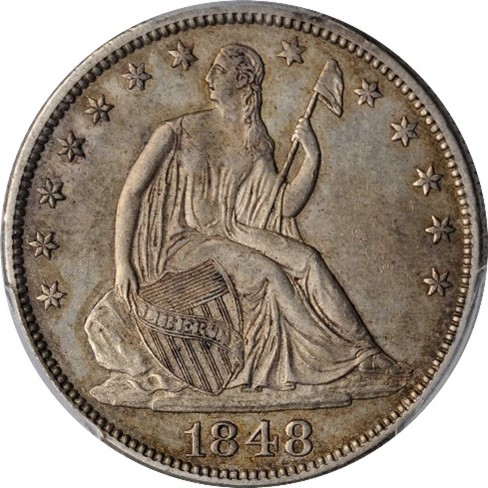
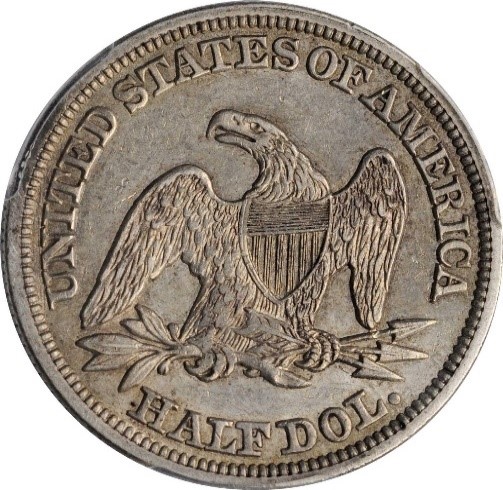
The 1848 Philadelphia Mint date commands somewhat of a premium in circulated grades. In March 2022, Gerry Fortin sold a CAC approved AU-53 grade 1848 for $1200.
An XF to AU grade 1849-O is slightly scarcer than XF to AU grade representatives of the least scarce dates from 1839 to 1852. Gerry Fortin sold the same CAC approved AU-53 grade 1849-O for $800 in February 2021 and for $895 in June 2021, retail prices in my estimation.
1850 Half Dollars
Although the 1850 is not one of the rarer dates in the series in the VF-20 to AU-55 grade range, it is a rare coin overall and not really recognized as such. I am almost certain that fewer than five hundred survive in all states of preservation.
U.S. citizens were reluctant to spend 1850 half dollars because the California Gold Rush upset the monetary order in the U.S. The official government ratio of silver to gold had not changed since 1834, yet vast quantities of gold were found in California. In free markets, the relative price of silver rose.
During the early 1850s, many people hoarded, had melted or traded U.S. silver coins for more than their respective face values. On the East Coast especially, silver was far more likely to be exported during the early 1850s than used to mint new half dollars in Philadelphia. From 1850 to 1852, it was not practical to mint many U.S. silver coins for circulation. The mintages of half dollars in Philadelphia each year from 1850 to 1852 were extremely low in contrast to the annual mintages in Philadelphia from 1842 to 1849. Production of half dollars at both the Philadelphia and New Orleans Mints was drastically reduced.
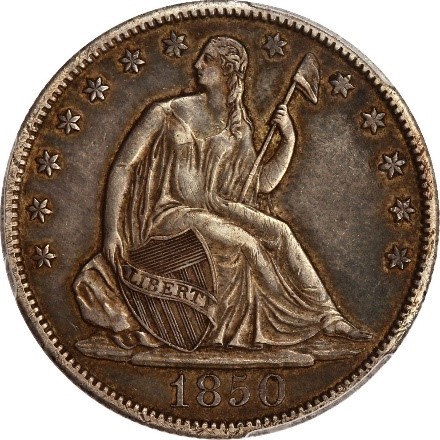
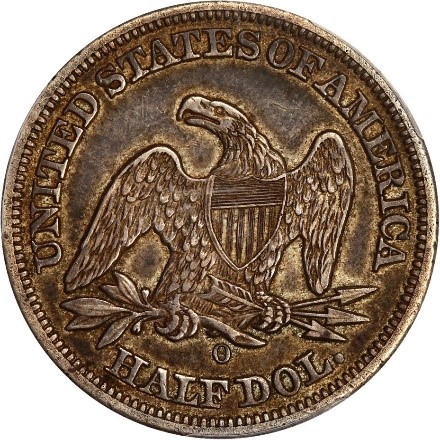
It may be difficult to find an 1850 half with a CAC sticker. In January 2022, Gerry Fortin sold a CAC approved XF-45 1850 for $1600, clearly a retail price.
Although more than 2.5 million 1850-O halves were minted, and price guides indicate that it is one of the least scarce dates, I suggest that it is even scarcer than it is believed to be. Much of the mintage was probably melted during the 1850s as an 1850-O half dollar then contained more than fifty cents worth of silver, if figured in gold. It was probably easy for moneychangers and dealers in metals to ship silver coins from the port of New Orleans, a major thoroughfare.
PCGS reports around 150 1850-O halves and NGC around 100, the total of which probably amounts to around two hundred different coins, maybe. There could be another eighty in ‘details’ holders and seventy-five more that are raw, probably less than 360 survivors in total.
CAC Approved 1850-O Half Dollars to 1852-O Halves
As of July 31, 2022, CAC has approved just twenty-five 1850-O halves, in all grades. In January 2021, the firm of Gerry Fortin sold a CAC approved AU-50 grade 1850-O for $685. This is one of very few CAC approved 1850-O halves to be publicly sold in recent years. Not many non-CAC coins have been sold either, and more than a few of those have serious problems. I suggest consulting an expert before spending more than $500 on a non-CAC 1850-O half.
CAC pops for the following dates are each even lower than the CAC population of 1850-O halves: 1851 (18), 1851-O (22), 1852 (15) and 1852-O (18). On March 19, 2020, Stack’s Bowers auctioned a CAC approved XF-40 grade 1851 half dollar for $1680. On Aug. 17, 2021, Stack’s Bowers auctioned a CAC approved AU-53 grade 1851 for $2280.
It may require some patience to find a CAC approved XF-40 to AU-55 grade 1851-O, though non-CAC examples are around. In circulated grades, 1851-O halves are much less rare than 1851, 1852 and 1852-O halves.
As of July 20, 2022, CAC has approved zero 1852 halves as VF-20 or VF-25, one as VF-30, one as VF-35, zero as XF-40, one as XF45, zero as AU-50, zero as AU-53, and three as AU-55. It would not make sense to count upon being able to buy one of these in the near future.
A significant number of non-CAC 1852 halves have serious problems, Although the 1852-O is not nearly as elusive as the 1852, many surviving 1852-O halves have problems, too. Because so many were melted or exported, there were not many around for collectors to acquire later in the nineteenth century, problematic 1852 and 1852-O half dollars were often collected because nicer coins were so difficult to find. Problematic half dollars from the 1840s, in contrast, were generally melted at some point, sometimes decades after they were minted. In other words, problematic 1852 and 1852-O halves were less likely to be melted and more likely to be collected than problematic halves from the 1840s.
In October 2021, Gerry Fortin sold a CAC approved, NGC graded AU-55 1852 for $2800. In July 2020, Fortin sold a CAC approved XF-40 grade 1852-O for $1250.
Essentially, the 1852 and 1852-O ended an era of Liberty Seated halves. Almost all 1853 half dollars are part of the next design type. There are known, however, fewer than five ‘With Drapery, No Motto, No Arrows’ 1853-O halves. I wrote an analytical article about these for another publication, which may still be found online for free. Most collectors of Liberty Seated coins regard the 1853-O ‘No Arrows’ half as non-collectible in the sense that it is unlikely to be obtained and should be ignored.
Generally, the dates from 1839 to 1852 are available; a set of these is not really hard to complete. If it was too easy, it would not be a fun project.
Images are copyrighted by Stack’s Bowers Galleries (www.stacksbowers.com), DLRC (www.DavidLawrence.com), and Heritage Auctions (www.ha.com).
Copyright © 2022 Greg Reynolds
About the Author
Greg is a professional numismatist and researcher, having written more than 775 articles published in ten different publications relating to coins, patterns, and medals. He has won awards for analyses, interpretation of rarity, historical research, and critiques. In 2002 and again in 2023, Reynolds was the sole winner of the Numismatic Literary Guild (NLG) award for “Best All-Around Portfolio”.
Greg has carefully examined thousands of truly rare and conditionally rare classic U.S. coins, including a majority of the most famous rarities. He is also an expert in British coins. He is available for private consultations.
Email: Insightful10@gmail.com
